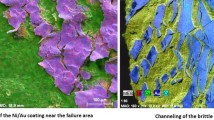Abstract
Copper planar microcoils were processed by U.V. lithography on SiO2/Si and Kapton®. They were packaged on different types of support in order to study the influence of thermal exchange conditions on device functioning. An electric current was injected in the coil and step by step increased until the electric connection broke, while the temperature of the microcoils remained free. This latter was estimated from the copper resistivity. It allowed demonstrating that the thermal exchange mode of the wire-bonded microcoils is conductive. The current density was calculated taking into account the deterioration of the coils by oxidation. Its maximum value is linearly decreasing with the thermal exchange ability of the support. The failure modes of the microcoils are related to track melting and oxidation, the current density remaining one order too weak to induce electromigration.







Similar content being viewed by others
References
Atta RMH (2004) Multi-layer double coil micro-fabricated transformer. Sens Actuators A Phys 112(1):61–65
Coutrot A-L et al (2001) Electromagnetic micro-device realized by electrochemical way. Sens Actuators A 91(1–2):80–84
Coutrot A-L et al (2002) Copper micromolding process for NMR microinductors realization. Sens Actuators A 99(1–2):49–54
Cugat O, delamare J, Reyne G (2003) Magnetic micro-actuators and systems (MAGMAS). IEEE Trans Magn 36(5):3607–3612
Gibbs MRJ (2005) Applications of magmems. J Magn Magn Mater 290–291(2):1298–1303
Kraft O, Arzt E (1997) Electromigration mechanism in conductor lines: void shape changes and slit-like failure. Acta Metall 45(4):1599–1611
Martincic E et al (2004) Magnetic micro-transformers realized with a flip-chip process. J Micromech Microeng 14:5558
Schindler G et al (2005) Reliability studies of narrow Cu lines. Microelectron Eng 82:645–649
Tu KN (2003) Recent advances on electromigration in very-large-scale-integration of interconnects. J Appl Phys 94(9):5451–5473
Wendrock H et al (2005) Correlation of electromigration defects in small damascene Cu interconnects with their microstructure. Microelectron Eng 82:660–664
Woytasic M et al (2007) Fabrication of planar and three-dimenional microcoils on flexible substrates. Microsyst Technol 12(10):973–978
Acknowledgments
This work was supported by the European network of excellence Patent DfMNM (Design for Micro & Nano Manufacture).
Author information
Authors and Affiliations
Corresponding author
Rights and permissions
About this article
Cite this article
Moulin, J., Woytasik, M., Grandchamp, JP. et al. High current densities in copper microcoils: influence of substrate on failure mode. Microsyst Technol 13, 1553–1558 (2007). https://doi.org/10.1007/s00542-007-0391-4
Received:
Accepted:
Published:
Issue Date:
DOI: https://doi.org/10.1007/s00542-007-0391-4




